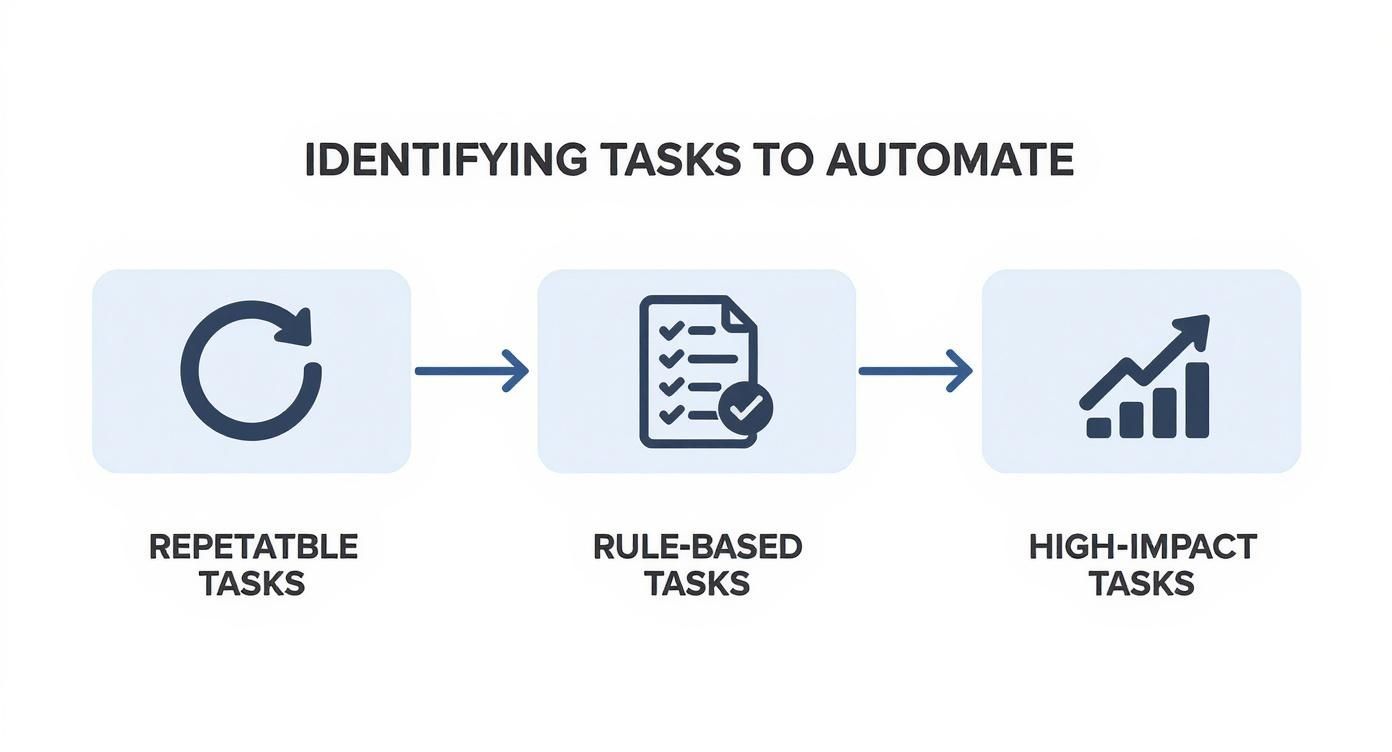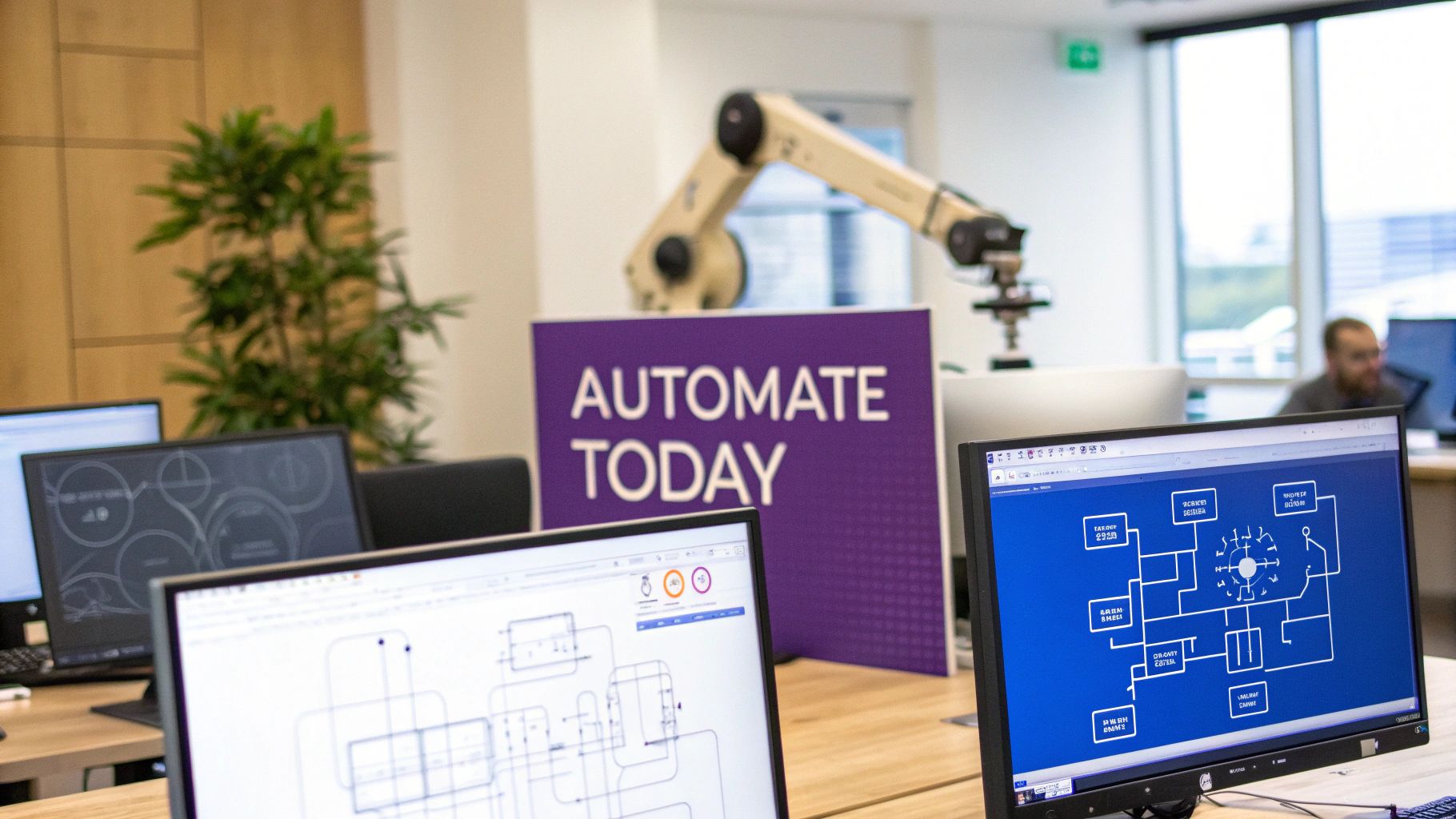How to automate business processes for faster workflows
Learn how to automate business processes with a practical, step-by-step guide to identifying opportunities, mapping workflows, and selecting the best tools.

Automating business processes is about using technology to take over the repetitive, manual work that slows down your team. Think of it as setting up systems to handle everything from data entry to customer follow ups, all without someone needing to constantly click, copy, and paste.
Why Automate Your Business Processes
Are you and your team spending too much time on tasks that feel like they could run on their own? A lot of businesses are making the shift to automation, and it’s about more than just getting back a few hours. The real win is in making your operations more reliable, efficient, and smarter.
When you get automation right, it creates a ripple effect across the entire organization.

One of the most immediate benefits is the sharp reduction in human error. Let’s be honest, manual data entry is a recipe for mistakes that can end up being pretty costly. An automated system that pulls customer info into your CRM doesn’t make typos. This alone leads to cleaner data and reporting you can actually trust.
The True Impact of Automation
Beyond just getting things right, automation does wonders for team morale. When people are freed from monotonous tasks, they can dig into the more engaging and creative work they were hired for. This shift doesn't just boost job satisfaction; it lets them contribute to the bigger goals that move the company forward.
We see companies experience a few core benefits right away:
- Reduced Operational Costs: Fewer manual hours spent on tedious work directly translates to lower labor costs. It just makes sense.
- Improved Consistency: Automated workflows play by the same rules every single time. That means invoicing, report generation, and other key tasks have a standard quality you can count on.
- Better Decision Making: With clean, real time data flowing in, leaders get a much clearer picture of what’s happening and can make strategic choices based on facts, not guesswork.
To put it in perspective, here's a quick look at the main advantages of bringing automation into your daily operations.
Key Benefits of Business Process Automation
Simply put, automation helps you do more with what you already have, setting your business up for smarter growth.
The momentum in this space is impossible to ignore. The global market for business process automation is expected to hit $23.9 billion by 2029, a massive leap from $13 billion in 2024. And with an estimated 85% of businesses planning to automate at least one process by 2029, this is quickly becoming standard practice, not a luxury.
By taking the robot out of the human, you allow people to focus on higher value activities that require creativity, critical thinking, and interpersonal skills. This change is about elevating your team, not just replacing tasks.
In the real world, this looks different everywhere you go. A finance team might automate invoice processing, matching purchase orders and flagging issues without anyone lifting a finger. In healthcare, automation can handle appointment reminders and patient data entry, giving staff more time for actual patient care.
If you're just getting started, this complete beginner's guide to AI workflow automation is a fantastic resource for building a solid foundation. We've also written about the many other workflow automation benefits that can give your business a competitive edge.
How to Find the Right Processes to Automate
You can't automate everything at once, so the big question is always where to begin. Jumping in without a clear target is one of the most common mistakes I see. A thoughtful approach to selecting your first few projects will build momentum and show your team the real value of automation from day one.
The best place to start is by looking for tasks that drain your team's energy and time. These are often the small, repetitive jobs that nobody enjoys but everyone has to do. Think daily data entry, weekly report generation, or that endless copy pasting between spreadsheets and your CRM.
Spot the Low-Hanging Fruit
To find the right processes, you need to become a bit of a detective. The best clues are usually found where work is predictable and follows a clear set of rules.
If you can write down the steps for a task in a simple checklist, there's a good chance it's a prime candidate for automation.
Here are the three main characteristics of tasks ripe for automation:
- Repetitive and Frequent: These are the jobs that happen over and over, like clockwork. Processing invoices, sending out standard email follow ups, or updating customer records are perfect examples.
- Rule Based and Standardized: The process follows a clear "if this, then that" logic. There’s very little guesswork or creative thinking required to get the task done right.
- High Volume or Time Consuming: Even a simple task can become a major bottleneck if it has to be done hundreds of times a day. Automating these high volume activities frees up a surprising amount of collective team hours.
For instance, an HR team might spend hours each week manually collecting timesheets, checking them for errors, and entering the data into the payroll system. This process is repetitive, follows clear rules, and eats up a ton of time, making it an ideal starting point. You can find more practical business process automation examples that apply to different departments, from sales to customer support.
Involve Your Team in the Discovery Process
You can't identify every inefficiency from a distance. The people doing the work every day have the best insights into what’s broken, what's frustrating, and what's slowing them down. Your team knows where the real bottlenecks are because they live with them.
Schedule short sessions with different departments and ask them simple questions:
- What's the most boring part of your job?
- Which tasks take up the most time for the least reward?
- If you could get rid of one daily task, what would it be?
Their answers will give you a goldmine of potential automation opportunities that you might have otherwise missed. Often, these are small inefficiencies that, when added up, represent a significant drain on productivity.
The goal is to find the pain points that, once removed, will make your team's work more meaningful and impactful. This approach gets your team excited about the change instead of seeing automation as a threat.
Prioritize for Quick Wins and High Impact
Once you have a list of potential processes, you need to prioritize. Not all automation projects are created equal. Some are quick to implement and deliver immediate value, while others are complex and require significant resources.
To make the right choice, evaluate each potential process against two key factors:
- Ease of Implementation: How difficult will it be to automate this process? Does it require complex integrations or just some simple workflow rules?
- Potential for Impact (ROI): How much value will this create? Think about time saved, errors reduced, and improvements in speed or quality.
Start with projects that are low effort but have a high impact. These are your "quick wins." They deliver visible results fast, which helps build confidence and support for more ambitious projects down the road. Automating a simple report generation task that saves five people an hour each week is a perfect example of a quick win that proves the concept.
Mapping Workflows Before You Automate
Trying to automate a business process without mapping it first is a classic rookie mistake. It’s like trying to build a house without a blueprint. You might end up with something standing, but it’s probably not what you wanted, and fixing it will be a nightmare.
This is why we always start with process mapping. It’s a non negotiable step that helps you automate a smooth, efficient workflow, not just pour concrete over a broken one.
So what is it? Process mapping is just creating a visual outline of a workflow, from the very first trigger to the final outcome. It forces you and your team to look at every single step, every decision, and every person involved. It’s about finally figuring out the "why" behind each action.
When you lay it all out visually, you start to see things that were hidden in plain sight. You’ll spot redundant steps, unnecessary approvals, or confusing handoffs that have been slowing everyone down for years without anyone realizing it.
Why You Can't Skip This Step
Automating a flawed process doesn't magically fix the flaws. All it does is make the bad process run faster, which usually creates even bigger problems down the line. A clear process map is your guide. It helps you simplify and improve the workflow before you even think about buying a tool or writing a single line of code.
It also gets everyone on the same page. When sales, marketing, and support can all see exactly how a lead flows from a form submission to a closed deal, it's much easier to agree on where the bottlenecks are and how to fix them. This shared understanding prevents arguments later and makes the actual implementation way smoother.
The graphic below shows a simple framework for identifying tasks ripe for automation, which is really the first part of your mapping journey.

As you can see, the best opportunities are repetitive, rule-based, and deliver a high impact. This is the foundation of a successful mapping exercise.
How to Map a Business Process
You don't need fancy software to get started. Honestly, a whiteboard, a pack of sticky notes, or a simple flowchart tool like Miro or Lucidchart will work just fine. The goal here is clarity, not complexity.
Here’s a practical way to get it done:
Define the Start and End Points: What action kicks off the process? What’s the final, desired outcome? For example, onboarding a new client starts the moment a contract is signed and ends when they are fully set up and ready to go in your system.
List Every Single Step: Walk through the process exactly as it exists today. Write down every action, no matter how small or seemingly insignificant. Don't try to improve it yet. Just document the reality of how work gets done right now.
Identify Who Does What: Assign a person or a team to each step. This is huge. It helps you see where handoffs occur, which are notorious sources of delays and miscommunication.
Pinpoint Decision Points: Where does the path branch out? Make a note of every point where a decision is made (e.g., "Is the invoice over $500?"). These "if then" moments are critical for designing solid automation logic.
By following these steps, you create a visual that everyone can look at, understand, and critique.
Think of mapping as the diagnostic phase of automation. You wouldn't want a doctor prescribing treatment without first knowing your symptoms. In the same way, you shouldn't apply an automation tool without first diagnosing the health of your process.
From Mapping to Improvement
Once your "as is" map is on the wall, the real work begins. Gather the team that actually runs the process and start asking the hard questions.
- Why do we do this step? Is it still necessary?
- Can we eliminate any of these approvals?
- Is there a simpler way to get this information?
- Where do people get stuck the most?
This collaborative review will almost always reveal opportunities to streamline the workflow. You might realize a weekly report no one reads can be replaced with a real time dashboard, or that a manual data entry step can be cut entirely just by integrating two of your existing systems.
I saw this firsthand with a marketing team that mapped out their content approval process. They discovered a single blog post went through seven different people for review, often sitting in someone's inbox for days at a time. By simplifying the workflow to just two key approvers and using an automated notification system, they cut their publishing time in half. That was before they even looked at more advanced automation tools.
This simplification phase is where the biggest wins often come from. By cleaning up the process first, you set your automation project up for massive success, making sure the technology you choose will be improving a workflow that is already lean, mean, and effective.
Choosing Your Automation Technology
With a clear process map in hand, you're ready to pick the right tech. The market is flooded with automation tools, and the sheer number of options can feel overwhelming. The key is to match the technology to the specific job you need it to do, thinking about things like cost, complexity, and how well it plays with your current systems.
You don't always need the most powerful or expensive solution. Sometimes, a simple workflow builder is all it takes to make a huge difference. Other times, you’ll need a more advanced platform to handle tricky logic or messy, unstructured data. The goal is to find the right fit for the process you’ve so carefully mapped out.
This is exactly where many businesses get stuck. They either choose a tool that's too simple for their needs or one that's far too complex and expensive for a straightforward task.

This screenshot shows the kind of interface you'll encounter when exploring different automation tools. Each one offers unique features and integrations, so the right choice depends entirely on your specific goals and existing tech stack.
Different Flavors of Automation Tools
Not all automation platforms are built the same. They generally fall into a few key categories, each suited for different kinds of tasks. Getting a handle on these categories will help you narrow down your search and make a much more informed decision.
Workflow Automation Platforms: These are often the easiest to use and are perfect for connecting your cloud based apps. Think of tools like Zapier or Make. They excel at creating simple "if this, then that" sequences, like automatically adding a new email subscriber to your CRM or posting a new blog entry to social media. They're great starting points for non technical teams.
Robotic Process Automation (RPA): This technology is designed to mimic human actions on a computer. RPA "bots" can log into applications, move files, copy and paste data, and fill out forms. It's a lifesaver for working with older, legacy systems that don't have modern APIs.
AI Powered Automation Platforms: This is where things get really interesting. These platforms use artificial intelligence and machine learning to handle more complex, judgment based tasks. They can understand unstructured data like emails or PDFs, make predictions, and even learn and adapt over time.
For a deeper dive into your options, check out our guide on the top business process automation tools available today.
The Rise of RPA and AI Integration
Robotic Process Automation (RPA) has become a foundational piece of the automation puzzle for many companies. It’s particularly effective at bridging the gap between old and new systems. In fact, the global RPA market was valued at $22.79 billion in 2024 and is expected to grow rapidly, which shows just how many businesses rely on it. Recent studies on RPA's impressive growth and adoption rates back this up.
However, the real power comes when you combine RPA with artificial intelligence. This blend, often called Intelligent Automation, allows you to automate entire end to end processes that require both rule based execution and cognitive decision making.
The best automation strategy isn't about choosing one type of tool over another. It's about building a toolkit where different technologies work together to solve specific problems. A simple workflow tool might handle your marketing tasks, while an AI platform tackles customer support.
A Practical Example with AI
Let's look at a common business challenge: customer service inquiries. A support team can get bogged down answering the same questions over and over again. This is a perfect use case for an AI driven platform like Chatiant.
Instead of a simple, rule based chatbot that can only answer pre programmed questions, an AI powered chatbot can be trained on your website's data, knowledge base, and past support tickets.
Here’s how it works in practice:
- A customer asks a question on your website's chat widget.
- The AI chatbot understands the intent behind the question, even if it's phrased in an unusual way.
- It instantly pulls the correct answer from your knowledge base and provides it to the customer.
- If the query is too complex or requires human intervention, the chatbot can intelligently route the conversation to the right support agent, complete with a summary of the interaction so far.
This kind of automation frees up your support team to focus on the high value, complex issues that truly require a human touch. The result is faster response times for customers and a more engaged, effective support team.
So, when choosing your technology, think about the specific process you want to automate. Is it a simple, linear workflow between two cloud apps? Or is it a more dynamic process that involves unstructured data and decision making? Answering this question is the single most important step in finding the right tool for the job.
Getting Your Automation Live: Implementation and Testing
https://www.youtube.com/embed/PjfMRRj7v4E
This is where all that careful planning and mapping starts to feel real. You’re ready to bring your automated workflow to life, but this isn’t the time to just flip a giant switch and hope for the best. A methodical, phased approach is the only way to launch successfully without throwing your team’s world into chaos.
The smartest way to kick things off is with a small pilot project. Think of it as a dress rehearsal.
By testing your new workflow in a controlled, limited environment, you can work out all the kinks and prove its value before rolling it out company wide. It's all about minimizing risk and gathering honest feedback from a small group of users who know the process inside and out.
Let’s say you’re automating customer onboarding. Instead of pushing every single new client through the new system at once, start with a select few. Maybe from one specific region or a particular service tier. This lets you watch the process like a hawk, fix any weird issues that pop up, and make sure the automation delivers the exact experience you designed.
Building and Refining Your First Workflow
As you start building, you’re essentially translating your process map into the logic of whatever tool you’ve chosen. Every step, decision point, and handoff you identified earlier now becomes a concrete action or rule in the digital workflow.
It’s completely normal at this stage to discover small gaps or edge cases you didn’t think of during the mapping phase. That’s okay! In fact, that's precisely why a pilot is so valuable. It gives you the breathing room to adjust and fine tune the workflow based on real world inputs, not just theory.
A few pointers to keep in mind as you build:
- Keep It Simple at First: Don't try to automate every single exception in your first pass. Focus on building the core workflow that handles 80% of the cases. You can always add complexity later.
- Document As You Go: Leave notes for your future self (and your team) explaining why you set up the logic a certain way. This will be a lifesaver for troubleshooting or scaling down the road.
- Bring in an Expert User: Have someone from the team who will actually use this process every day sit with you during the build. They’ll spot practical issues and awkward steps you might otherwise miss.
This iterative cycle of build, test, refine is the key to a successful implementation.
Rigorous Testing for a Smooth Launch
Testing isn’t just about making sure the automation runs without crashing. It’s about confirming that it produces the right outcomes, every single time. A workflow that runs flawlessly but sends the wrong invoice to a customer is far worse than no automation at all.
Your testing process needs to be thorough and cover a range of scenarios:
- The "Happy Path": First, test the workflow with perfect, standard data to make sure it works as expected under ideal conditions. This is your baseline.
- Edge Cases: What happens if a field is left blank or someone enters data in the wrong format? Test for common, everyday errors to see how gracefully the automation handles them.
- Failure Scenarios: Now, intentionally try to break it. This is how you find your weak spots and build in proper error handling and alerts, so you know immediately when something goes wrong.
To make sure your new processes are truly reliable, a comprehensive automated testing tools comparison can be a huge help here, guiding you to the right solutions for rigorous validation.
A successful pilot isn't one that runs perfectly from the start. A successful pilot is one that helps you find and fix all the problems before the automation goes live for everyone. It's your safety net.
Once your pilot is running smoothly and you’ve squashed the major bugs, you can start planning the wider rollout. This is all about clear communication. Let the entire team know what the new process is, why it’s changing, and how it’s going to make their jobs easier. A little bit of training and simple documentation goes a long way in making sure everyone feels confident from day one. This careful, methodical launch is what separates a successful automation project from a disruptive one.
Measuring Success and Scaling Your Efforts
Launching your automation is a huge step, but it’s definitely not the finish line. The real question is, how do you know if it's actually working?
You can’t improve what you don’t measure. Without clear metrics, you’re just guessing. Measuring the impact of your automated processes is the only way to prove their value, justify future investment, and build a solid case for scaling your efforts across the organization. It's all about creating a cycle of continuous improvement.
Defining Your Key Metrics
So, what should you actually be tracking? The right key performance indicators (KPIs) will depend on the process you automated, but they usually fall into a few core categories. These give you a clear, objective view of where your automation is making the biggest difference.
Here are the important metrics to start with:
- Process Cycle Time: How long does it take to get from start to finish? A significant drop here is one of the most direct signs of a win.
- Error Rate Reduction: Compare the number of mistakes that happened when things were manual versus now. A lower error rate means higher quality work and less time spent on fixing things.
- Cost Savings: This is the direct financial impact. Think hours saved (multiplied by employee cost), lower operational expenses, and eliminating the costs tied to manual errors.
- Throughput or Volume: How many tasks can the automated process handle in a given time? An increase shows you can scale operations without needing to scale your headcount proportionally.
- Employee Satisfaction: Don’t forget the human element. Check in with the team to see if the automation has made their jobs less tedious and more engaging.
Tracking these numbers moves the conversation from "I think this is working" to "We've cut our invoice processing time by 72% and reduced data entry errors to nearly zero." Now that's a powerful story to tell.
Using AI to Find Your Next Opportunity
Your first successful automation is just the beginning. The next move is to use technology to find new bottlenecks and spot more complex opportunities that might not be obvious at first glance. This is where AI and process mining really shine.
Process mining tools analyze the digital footprints left behind in your systems, like timestamps and activity logs, to create a visual map of how your workflows actually run. This often reveals surprising detours from the official process, showing you exactly where work gets stuck.
Think of process mining as an MRI for your business operations. It gives you a detailed, data driven picture of your organizational health, highlighting hidden inefficiencies you would never find through interviews or manual observation alone.
The integration of artificial intelligence is changing how businesses approach automation. For example, organizations using advanced automation have seen workflow speeds improve by up to 60%, and a 25% reduction in operational costs. These numbers show a clear trend toward smarter, more adaptive systems. You can discover more insights about the future of business process automation on codewave.com.
Scaling Intelligently Across the Organization
With proven results in hand, you can start scaling your automation strategy. But "scaling" isn't about automating everything for the sake of it. It means being strategic and applying what you’ve learned to tackle bigger, more impactful challenges.
A smart scaling strategy involves a few key steps:
- Create a Center of Excellence (CoE): This is a dedicated team responsible for setting best practices, providing support, and guiding automation initiatives across the company.
- Reuse Automation Components: Develop a library of reusable automation "bots" or workflow templates. This makes future projects faster and helps with consistency.
- Prioritize Based on Business Impact: Use a clear framework to decide which processes to automate next. Focus on the ones that align with major company goals and offer the highest potential ROI.
By taking this structured approach, you turn automation from a series of one off projects into a core part of your business strategy, a powerful engine for continuous growth.
Ready to automate your customer service and internal support? Chatiant lets you build custom AI agents trained on your own data. Free up your team and provide instant, accurate answers on your website, Slack, or Google Chat. Learn more and get started with Chatiant today.


